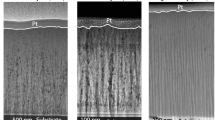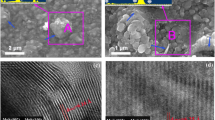Abstract
The temperature-dependent friction and wear of magnetron-sputtered MoS2/Sb2O3/Au nanocomposites was investigated in the range −150 to 150 °C using macroscale experiments. We investigate the origin of recent reports suggesting the existence of a relatively high friction (µ ~ 0.2) transition for these nanocomposites at temperatures below −20 °C, contrasting with the characteristic ultra-low friction behavior (µ < 0.01) for pure and composite MoS2 films in vacuum and inert gas environments at room temperature. We present evidence suggesting that the ability to form and maintain basally oriented low-friction surface films is increasingly compromised with decreasing temperature, and show that low friction is achievable at cryogenic temperatures.



Similar content being viewed by others
References
Gardos, M.N.: Self-lubricating composites for extreme environment applications. Tribol. Int. 15, 273–283 (1982). doi:10.1016/0301-679X(82)90084-6
Fusaro, R.L.: Self-lubricating polymer composites and polymer transfer film lubrication for space applications. Tribol. Int. 23, 105–122 (1990). doi:10.1016/0301-679X(90)90043-O
Evans, D.C., Senior, G.S.: Self-lubricating materials for plain bearings. Tribol. Int. 15, 243–248 (1982). doi:10.1016/0301-679X(82)90077-9
Khare, H.S., Burris, D.L.: Surface and subsurface contributions of oxidation and moisture to room temperature friction of molybdenum disulfide. Tribol. Lett. 53, 329–336 (2014). doi:10.1007/s11249-013-0273-0
Voevodin, A.A., Hu, J.J., Fitz, T.A., Zabinski, J.S.:Tribological properties of adaptive nanocomposite coatings made of yttria stabilized zirconia and gold. Surf. Coat. Technol. 146–147, 351–356 (2001). http://www.sciencedirect.com/science/article/pii/S0257897201013962
Hu, J.J., Wheeler, R., Zabinski, J.S., Shade, P.A., Shiveley, A., Voevodin, A.A.: Transmission electron microscopy analysis of Mo–W–S–Se film sliding contact obtained by using focused ion beam microscope and in situ microtribometer. Tribol. Lett. 32, 49–57 (2008). doi:10.1007/s11249-008-9360-z
Voevodin, A.A., Zabinski, J.S.: Nanocomposite and nanostructured tribological materials for space applications. Compos. Sci. Technol. 65, 741–748 (2005). doi:10.1016/j.compscitech.2004.10.008
Hamilton, M., Alvarez, L., Mauntler, N., Argibay, N., Colbert, R., Burris, D., Muratore, C., Voevodin, A., Perry, S., Sawyer, W.: A possible link between macroscopic wear and temperature dependent friction behaviors of MoS2 coatings. Tribol. Lett. 32, 91–98 (2008). doi:10.1007/s11249-008-9366-6
Scharf, T.W., Kotula, P.G., Prasad, S.V.: Friction and wear mechanisms in MoS2/Sb2O3/Au nanocomposite coatings. Acta Mater. 58, 4100–4109 (2010). doi:10.1016/j.actamat.2010.03.040
Stoyanov, P., Chromik, R.R., Goldbaum, D., Lince, J.R., Zhang, X.: Microtribological performance of Au–MoS2 and Ti–MoS2 coatings with varying contact pressure. Tribol. Lett. 40, 199–211 (2010). doi:10.1007/s11249-010-9657-6
Singh, H., Mutyala, K.C., Evans, R.D., Doll, G.L.: An investigation of material and tribological properties of Sb2O3/Au-doped MoS2 solid lubricant films under sliding and rolling contact in different environments. Surf. Coat. Technol. 284, 281–289 (2015). doi:10.1016/j.surfcoat.2015.05.049
Zhao, X., Phillpot, S.R., Sawyer, W.G., Sinnott, S.B., Perry, S.S.: Transition from thermal to athermal friction under cryogenic conditions. Phys. Rev. Lett. 102, 186102 (2009). doi:10.1103/PhysRevLett.102.186102
Zhao, X., Hamilton, M., Sawyer, W.G., Perry, S.S.: Thermally activated friction. Tribol. Lett. 27, 113–117 (2007). doi:10.1007/s11249-007-9220-2
Colbert, R.S., Sawyer, G.W.: Thermal dependence of the wear of molybdenum disulphide coatings. Wear 269, 719–723 (2010). doi:10.1016/j.wear.2010.07.008
Kubart, T., Polcar, T., Kopecký, L., Novák, R., Nováková, D.: Temperature dependence of tribological properties of MoS2 and MoSe2 coatings. Surf. Coat. Technol. 193, 230–233 (2005). doi:10.1016/j.surfcoat.2004.08.146
Gardos, M.N.: Anomalous wear behavior of MoS2 films in moderate vacuum and dry nitrogen. Tribol. Lett. 1, 67–85 (1995). doi:10.1007/bf00157977
Babuska, T.F., Pitenis, A.A., Jones, M., Nation, B.L., Sawyer, W.G., Argibay, N.: Temperature dependent friction behavior of PTFE and MoS2, Tribol. Lett. 63, 15 (2016). doi:10.1007/s11249-016-0702-y10.1007/s11249-016-0702-y
Bares, J.A., Argibay, N., Mauntler, N., Dudder, G.J., Perry, S.S., Bourne, G.R., Sawyer, W.G.: High current density copper-on-copper sliding electrical contacts at low sliding velocities. Wear. 267, 417–424 (2009). http://www.sciencedirect.com/science/article/B6V5B-4WC0RK8-1Y/2/4b72f50fa3bc1ae4c4aaec46b193b0d9
Winer, W.O.: Molybdenum disulfide as a lubricant: A review of the fundamental knowledge. Wear 10, 422–452 (1967). doi:10.1016/0043-1648(67)90187-1
Archard, J.F.: Contact and rubbing of flat surfaces. J. Appl. Phys. 24, 981–988 (1953)
Curry, J.F., Argibay, N., Babuska, T.F., Nation, B.L., Martini, A., Strandwitz, N.C., Krick, B.A.: Highly oriented MoS2 coatings: tribology and environmental stability. Tribol. Lett. 64, 11 (2016)
Acknowledgments
The authors would like to thank Somuri V. Prasad and Michael T. Dugger for helpful conversations about the friction behavior of MoS2 in extreme environments, Rand Garfield for sample preparation and assistance with fabrication of cryogenic flow cell, and Angela Pitenis, Morgan Jones and W. Gregory Sawyer for insightful conversations about previous research efforts to understand the molecular origins of friction of 2D materials. Sandia National Laboratories is a multi-program laboratory managed and operated by Sandia Corporation, a wholly owned subsidiary of Lockheed Martin Corporation, for the U.S. Department of Energy’s National Nuclear Security Administration under contract DE-AC04-94AL85000.
Author information
Authors and Affiliations
Corresponding author
Rights and permissions
About this article
Cite this article
Curry, J.F., Babuska, T.F., Brumbach, M.T. et al. Temperature-Dependent Friction and Wear of MoS2/Sb2O3/Au Nanocomposites. Tribol Lett 64, 18 (2016). https://doi.org/10.1007/s11249-016-0748-x
Received:
Accepted:
Published:
DOI: https://doi.org/10.1007/s11249-016-0748-x




